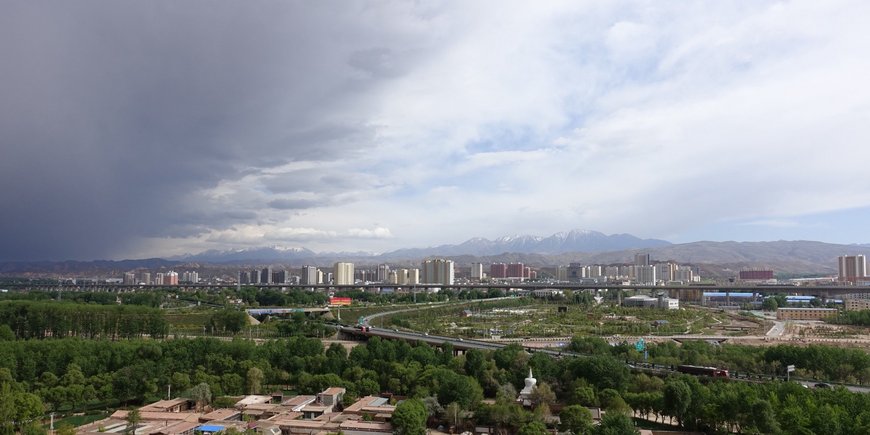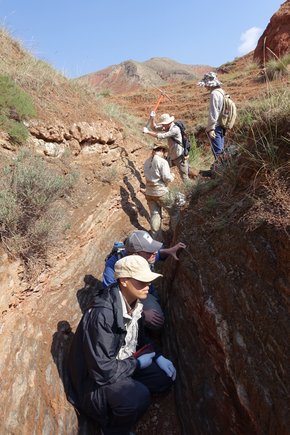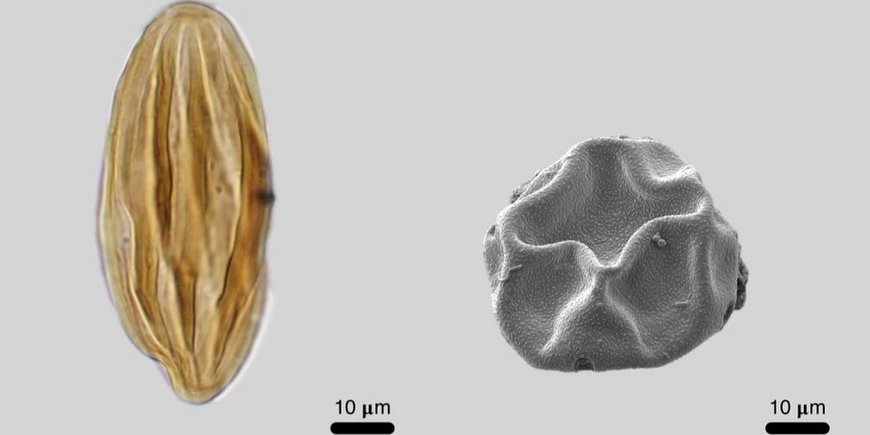Summary
One of the great uncertainties of global climate change is how the Asian monsoon and the regions in Central Asia shaped by it will react to future changes in climate. A look at extreme climatic events in the past provides an impression of possible scenarios: around 56 million years ago, an increase in greenhouse gases in the atmosphere led to an abrupt rise in temperature and thus an increase in precipitation and vegetation in Central Asia. This was shown by an international research team led by Niels Meijer from the Senckenberg Biodiversity and Climate Research Centre (SBiK-F) and with the participation of the GFZ German Research Centre for Geosciences. As part of the interdisciplinary project “VeWA” (“Past warm periods as natural analogues of our ‘high CO2’ climate future”), they investigated the dry areas of Central Asia over long periods of their geological history using fossil pollen, spores and geochemical data from fossil soils. The results were recently published in the scientific journal Nature Geoscience.
The steppe landscape of Central Asia in a changing climate
Today, vast treeless steppes characterize the landscape of Central Asia. The sparse rainfall that reaches the Asian interior is mostly caused by monsoon events in summer or the westerly winds of the mid-latitudes in winter and spring. “Such grassland steppes are particularly susceptible to the consequences of changes in temperature and precipitation – with all the consequences for their inhabitants such as the Saiga antelope or the endangered Przewalski's horse,” explains Niels Meijer and continues: “One of the great uncertainties of global climate change is how the Asian monsoon and the regions in Central Asia shaped by it will react to future changes in climate”.
Learning from the past for the future
We can learn how global climate change will affect the landscapes and living conditions of the future from developments in earlier warm periods of the Earth's history.
Niels Meijer and his team have therefore investigated the effects of extreme climate changes in the early Eocene period 57 to 44 million years ago on vegetation and precipitation in Central Asia, where drought prevailed over long periods of geological history.
Dr Niels Meijer is now a scientist at the Senckenberg Biodiversity and Climate Research Centre (SBiK-F) in the VeWA research project. The abbreviation VeWA stands for “Past warm periods as natural analogues of our ‘high CO2’ climate future”. Co-author Dr Guillaume Dupont-Nivet conducts research at the GFZ German Research Centre for Geosciences in Section 4.3 “Climate Dynamics and Landscape Evolution”. Niels Meijer started his work on the now published topic during his PhD at the GFZ in the team of Guillaume Dupont-Nivet.
Reconstruction of the past climate from a combination of fossil data
Precisely at 56 million years ago was a global warm phase caused by greatly increased input of greenhouse gases into the Earth's atmosphere and oceans. During this short event, the global temperature rose by an average of six degrees Celsius within a few thousand years.
In order to reconstruct the precipitation patterns of that time, the researchers combined their expertise to develop an innovative so-called multi-proxy approach in which they combined fossil pollen and spores as well as geochemical data from fossil soils as indicators for the development of precipitation and vegetation.
They picked up samples in the area of Xining in western China along an amazingly long climatic archive they precisely dated (see Fig. 2). They found a peculiar 2-meter-thick layer with a strange liver colour corresponding to the warm event 56 million years ago. That layer contains very distinctive fossil pollen grains of humid forest taxa such as chestnut trees, totally different from the extremely dry desert plants in the rest of the records. The preserved rainwater in fossilized soils from that layer also shows a huge increase in rainfall. Interestingly, the fossil soils can be shown to have evaporated following strong summer rains, typical of monsoons.
56 million years ago: Doubling of precipitation and forest growth
“During the hyperthermal event we studied, precipitation temporarily doubled due to the higher temperatures and the regional steppe was replaced by a forest landscape,” Meijer describes the results and adds: “More importantly, however, we were able to use geochemical data to show that the soils dried out in winter, meaning that, contrary to expectations, most of the precipitation fell during the summer period – comparable to the modern monsoon.”
Scientists attribute the unusually wet period during the “Paleocene/Eocene temperature maximum” to a far inland expansion of precipitation – so-called proto-monsoons. “The abrupt greening of the Central Asian steppe desert resulting from the monsoon climate probably also enabled the spread of new mammal species and may also have played a role in the feedbacks of the global carbon cycle,” summarizes Meijer and concludes: “Our work provides paleoclimatic evidence for an abrupt and non-linear response of Asian monsoons to extreme greenhouse conditions. Although the seas and mountains of Asia 56 million years ago were very different from today, the data highlight the potential for abrupt changes in Central Asian precipitation and ecosystems under future global warming. Current warming with extreme temperature and increased drought burdens Central Asian steppe and its fragile flora and fauna, which are already endangered by anthropogenic land use. Yet more dramatic abrupt changes are expected if temperatures continue to increase”.
Co-Autor Guillaume Dupont-Nivet points out: “Our study shows: In a warming world, monsoons can occur more frequently and bring more precipitation. This may be good news for the desertic areas inland in the long term. But currently, the change is happening too quickly, with extreme events from wet to dry that have devastating effects on fragile crop and steppe fauna. In other areas of Asia, too, this is accompanied by an increase in extreme events that lead to disasters. Typically, uncontrolled flooding is increasing dramatically in India and Bangladesh, as other studies have shown and has been observed recently.”
With text from the Senckenberg Biodiversity and Climate Research Centre (SBiK-F).
Original publication
Meijer, N., Licht, A., Woutersen, A. et al. Proto-monsoon rainfall and greening in Central Asia due to extreme early Eocene warmth. Nat. Geosci. 17, 158–164 (2024). https://doi.org/10.1038/s41561-023-01371-4
Scientific Contact:
Dr. Guillaume Dupont-Nivet
Section 4.3 Climate Dynamics and Landscape Evolution
Helmholtz Centre Potsdam
GFZ German Research Centre for Geosciences
Potsdam, Germany
CNRS, Rennes, France
E-Mail: gdn@gfz-potsdam.de
Web: www.paleoenvironment.eu
Dr. Niels Meijer
Senckenberg Biodiversity and Climate Research Center (SBiK-F)
Frankfurt am Main, Germany
E-Mail: niels.meijer@senckenberg.de






